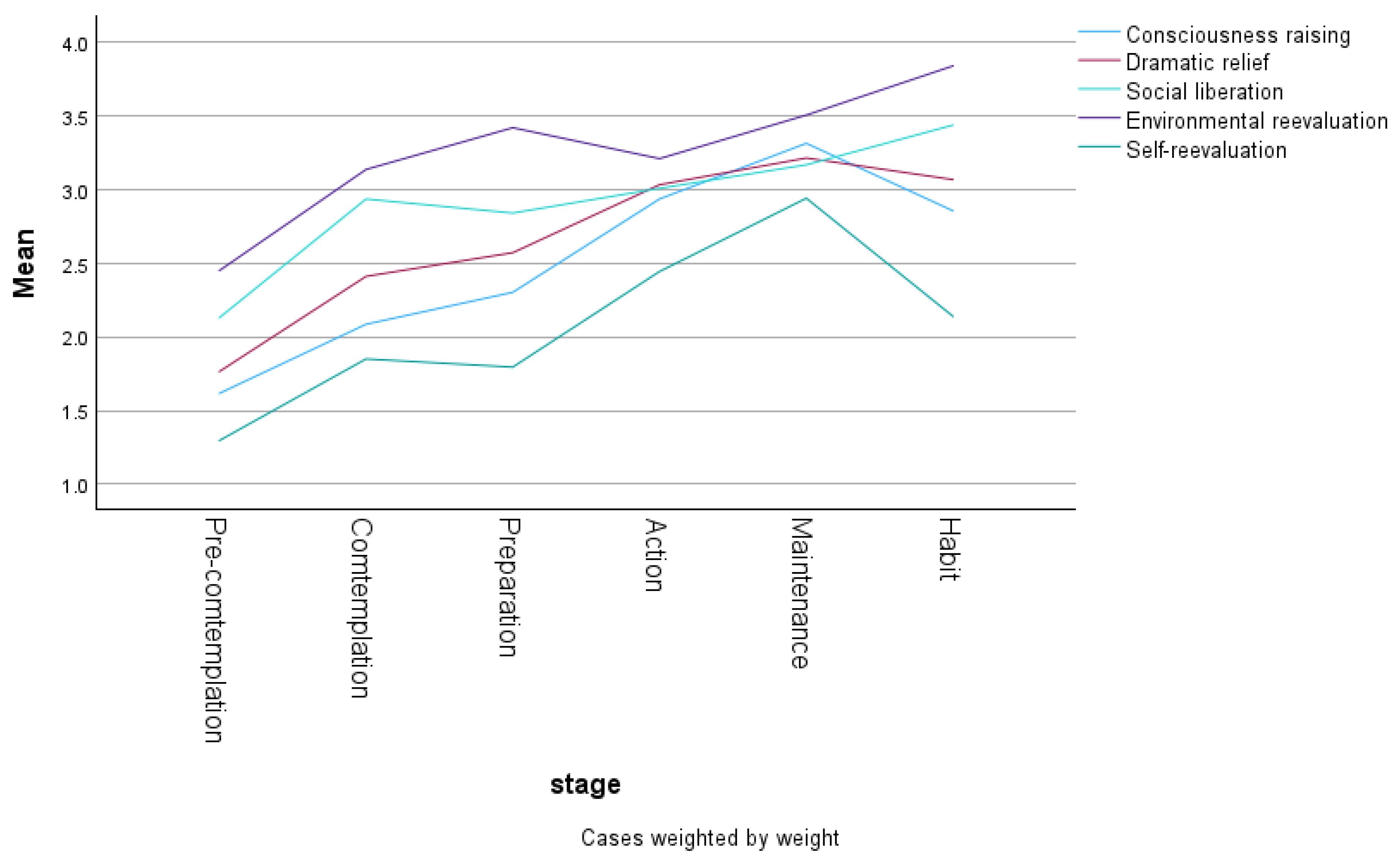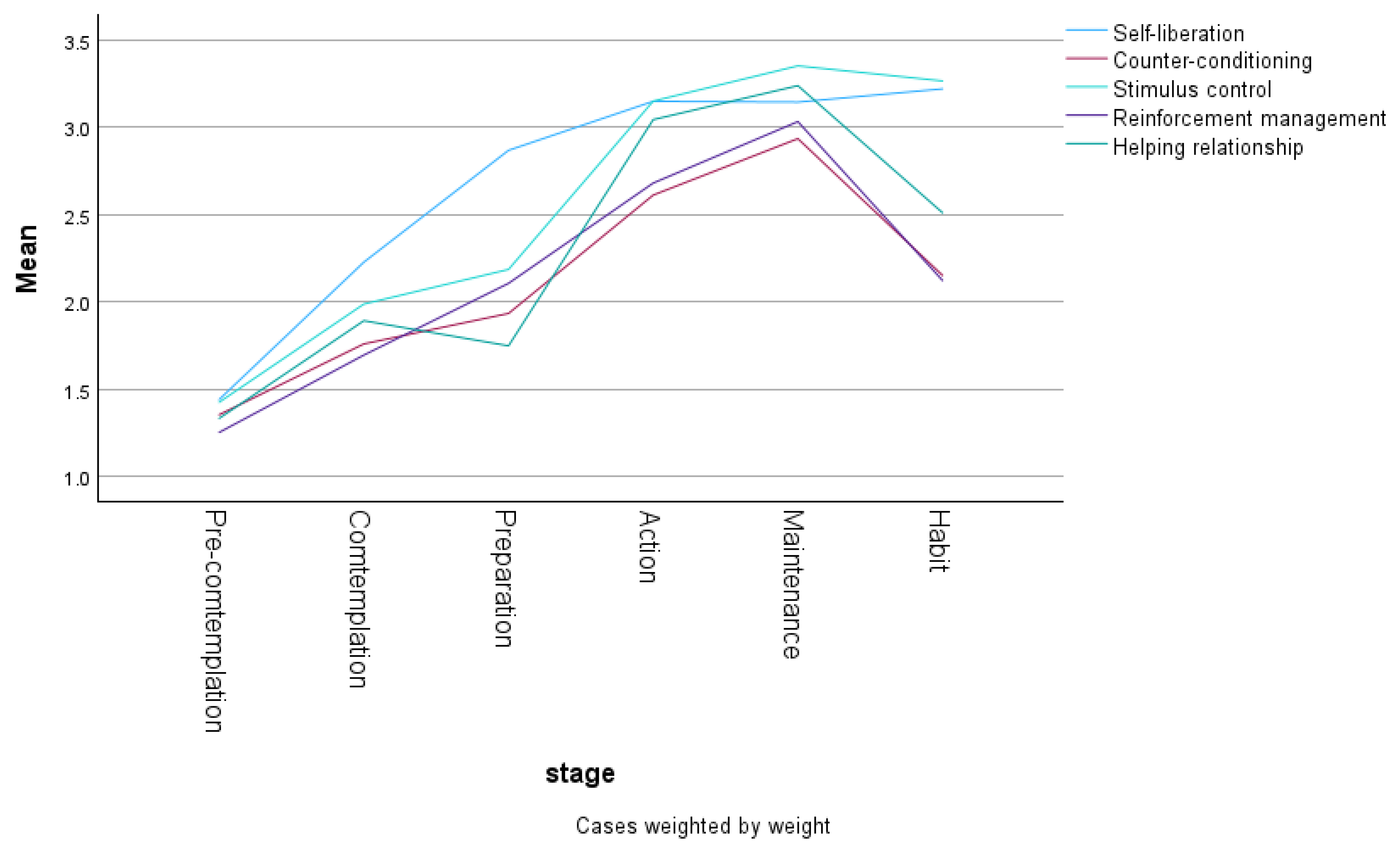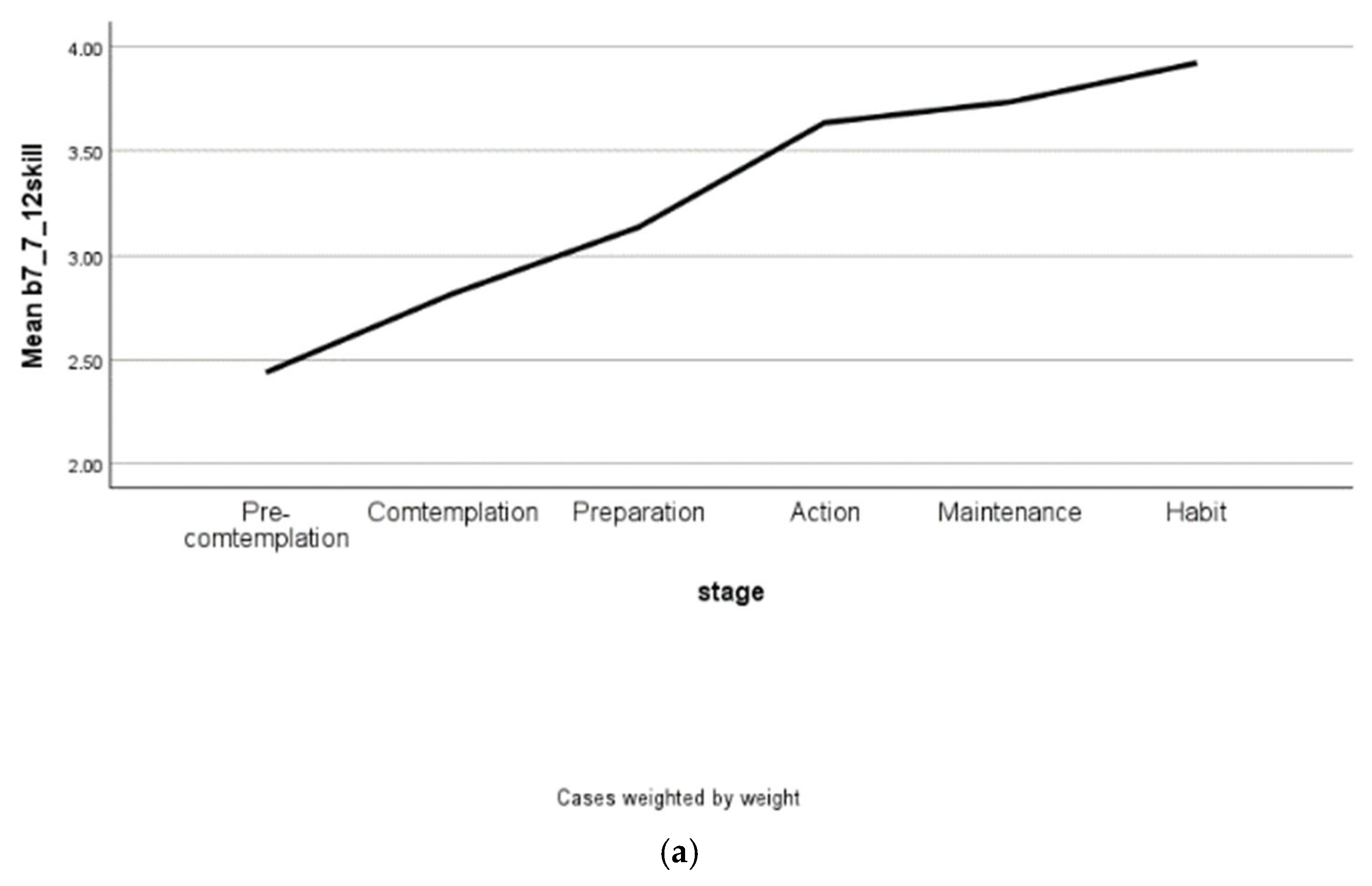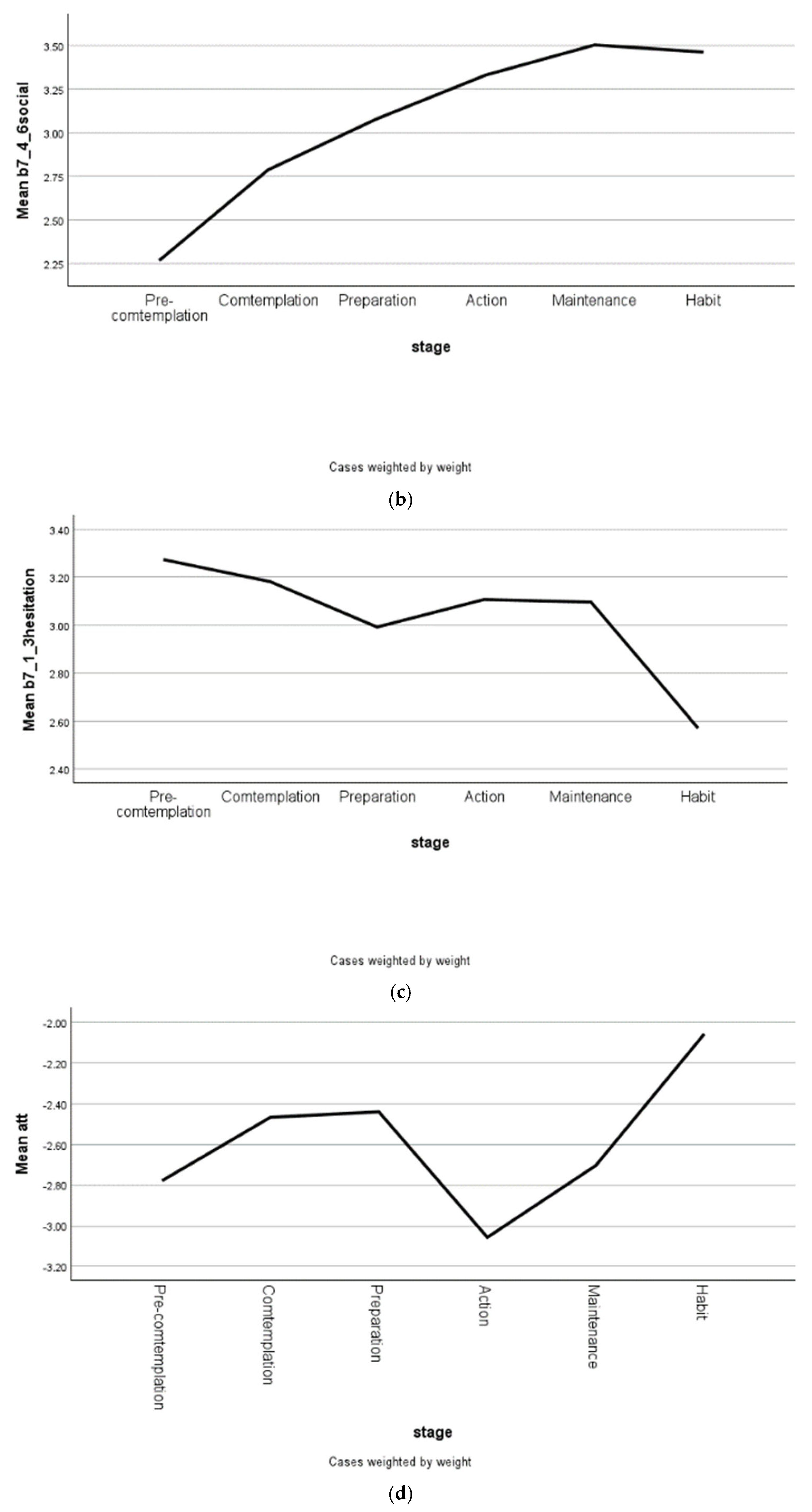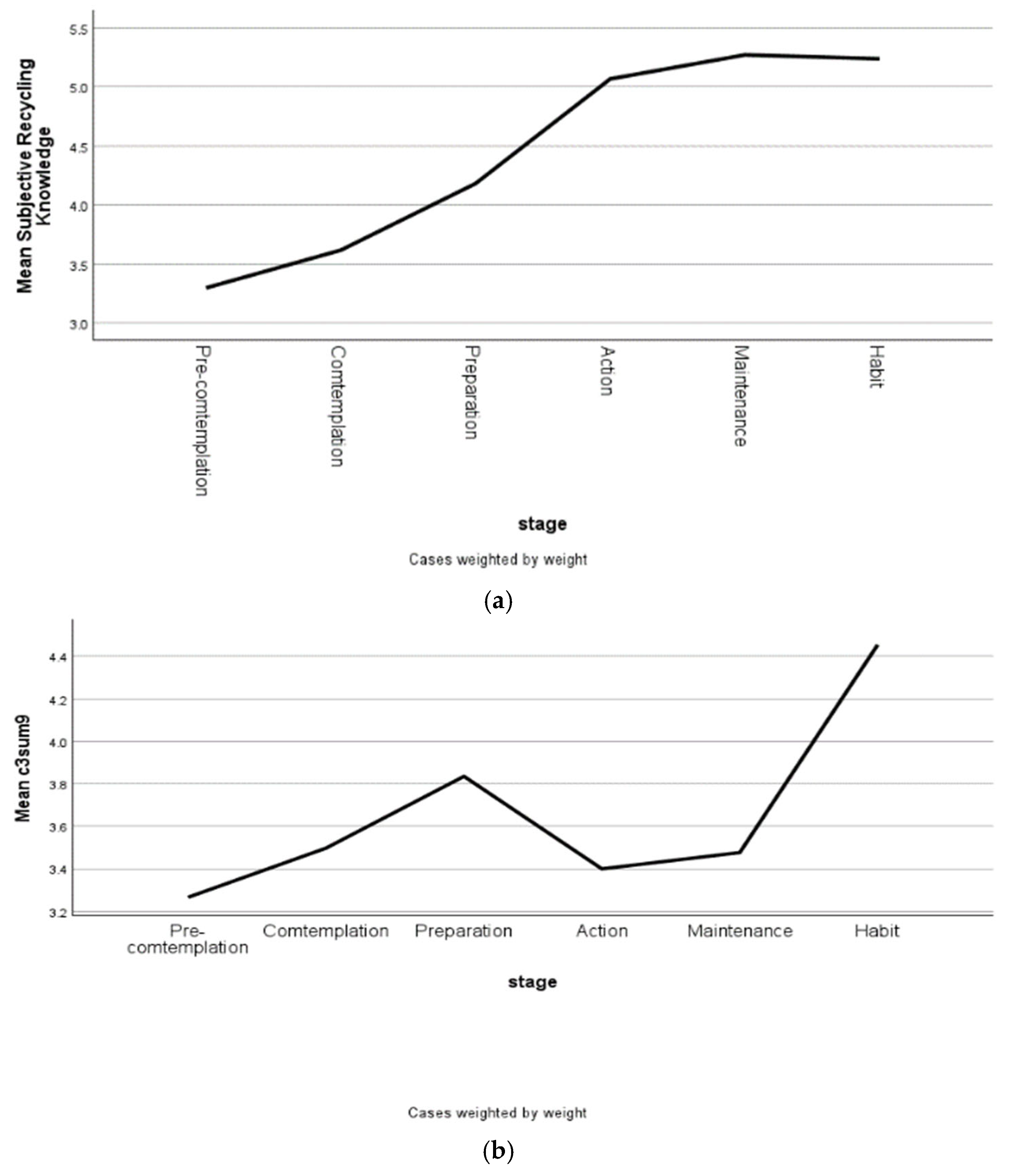1. Introduction
Sustainable consumer behavior refers to any behavior that benefits environmental protection and social justice [
1,
2]. Research shows that sustainable consumer behavior is positively associated with life satisfaction [
3,
4]. Recycling behavior is one type of sustainable behavior which has been studied extensively [
5,
6,
7,
8,
9]. Being willing to recycle and recycling appropriately require certain levels of knowledge and willpower to enact. How to recycle waste appropriately is a challenge to many people since different types of waste need to be recycled differently [
10]. Many previous studies have applied the theory of planned behavior to identifying the factors associated with behavior intensions related to recycling [
11,
12,
13,
14,
15,
16,
17,
18,
19,
20,
21]. However, research on recycling behavior that focuses on behavior change stages is limited.
The purpose of this study, which is part of a larger study, is to identify the behavior change stages in consumer recycling behavior based on the transtheoretical model of behavior change (TTM) and to examine consumer group differences between these change stages using national data in the U.S.
The TTM is a theory for identifying factors that facilitate individuals to change their behaviors [
22,
23]. Unlike other behavior science theories, it defines behavior changes using five stages (precontemplation, contemplation, preparation, action, and maintenance). It identifies ten change processes that can be considered potential intervention strategies used by helping professionals, which are
consciousness-raising,
dramatic relief,
social liberation,
environmental reevaluation,
self-reevaluation,
self-liberation,
counter-conditioning,
stimulus control,
reinforcement management, and
helping relationships. These change processes are abstracted from major psychological theories [
23]. Based on the predication of the TTM, when consumers develop a new desirable behavior or eliminate an old undesirable behavior, they show several outcomes such as decisional balance (measured by the pros and cons of the target behavior) and confidence. From the earlier stages to the later stages of behavior change, the pros and confidence levels increase while the cons decrease. The most unique feature of the TTM is that for effective behavior change, different change processes should match the different change stages [
23]. The TTM has been widely used in health, finance, and other domains [
23,
24]. However, research on recycling behavior using the TTM is limited. In this study, under the guidelines of this theory and the associated literature, research questions were developed, and a national survey was conducted. We attempted to answer the following research questions:
What is the status of consumer recycling behavior by behavior change stage?
What psychological, cognitive, socioeconomic, and environmental factors associated with consumer recycling behavior differ by behavior change stage?
These research questions aim to address a research gap in the literature. Most empirical studies on consumer recycling behavior have applied the theory of planned behavior, in which the factors associated with recycling behavior are identified [
11,
12,
13,
14,
15,
16,
17,
18,
19,
20,
21]. However, little research has examined the change stages for recycling behavior. Using the lens of the TTM, we are able to examine the factors associated with the behavior change stages in consumer recycling, contributing to the literature on recycling behavior.
To answer these questions, we test the validity of the TTM regarding behavior change stages in the context of recycling. In addition, we also test whether the TTM’s predictions of the associations between behavior change stages and outcomes (measured using a set of psychological factors) are valid. This study has both theoretical and practical significance. Theoretically, this study examines the factors associated with recycling behaviors, which enriches the literature on sustainable consumer behavior and confirms or disconfirms previous research on the factors associated with recycling behavior in other contexts. The results also test the validity of the theory, the TTM, and contribute to the theory-building in the literature on sustainable consumer behavior. From a public policy perspective, the results provide information for policy makers when they develop and implement environmental management and education programs. The results show the status of recycling behavior by behavior change stage among American consumers. They also show the differences in the psychological, cognitive, socioeconomic, and environmental factors between behavior change stages, which have implications for developing interventions to encourage consumer recycling behavior.
Compared to the previous research, this study has three innovations. First, it is theory-based, namely using the transtheoretical model of behavior change (TTM). Second, it is a joint project between researchers and practitioners. The university researchers worked with the practitioners in a state environment protection agency and a resource recovery corporation to develop and design this study. With this unique cooperation, the project is theoretically sound and practically meaningful. Third, this study examines the psychological and cognitive factors associated with recycling behavior between behavior change stages. It provides insights on behavioral change processes and has implications for developing interventions to encourage consumers to engage in recycling behavior. Its findings are informative for professionals in waste management and recycling policy and education.
3. Discussions, Limitations, and Implications
3.1. Discussions
This study used data collected from the U.S. to describe the status of and the factors associated with behavior change stages under the guidance of the transtheoretical model of behavior change (TTM). The results show interesting patterns regarding the two research questions asked.
For the first research question, this study identified the behavior change stages in consumer recycling. The results show that most of the consumers (76.5%) engaged in recycling behavior at various behavior change stages, while a minority of consumers (23.5%) were still not engaging in recycling behavior. Among them, 12.8% never considered recycling. It is a challenge to motivate consumers who never consider recycling in the near future.
The second research question asked what factors were associated with the behavior change stages among American consumers. The one-way ANOVA results show that consumer change processes that can be considered change strategies used by consumers to change their behavior are different from the earlier stages to the later stages. Two patterns are shown: one pattern is an upward pattern, from low to high over the behavior change stages, and the other is an upward pattern until the stage before the last stage that then declines. These findings are not consistent with the theoretical predictions of the TTM, in which change processes and change stages are matched in a specific way. Based on the TTM’s predictions, change processes are more effective across certain change stages. For example,
consciousness-raising,
environmental reevaluation, and
dramatic relief are more effective between pre-contemplation and contemplation;
self-reevaluation is more effective between contemplation and preparation;
self-liberation is more effective between preparation and action;
helping relationships,
reinforcement management,
counter-conditioning, and
stimulus control are more effective between action and maintenance; and
social liberation is effective for transitioning between all change stages [
22]. Our findings do not show these patterns exactly. We did not find other studies that had applied the TTM to examining recycling behavior. We did find a study that had applied the TTM to examining pro-environmental behavior [
26], in which the factors were not compared across behavior change stages. One study that applied TTM to financial behavior showed patterns that were not exactly consistent with the TTM’s predictions but were broadly consistent [
24]. Many published studies have applied the theory of planned behavior (TPB) to recycling behavior, based on a review [
9]. The TPB is an ideal theoretical framework for understanding the factors associated with a target behavior, including recycling behavior [
25]. However, it is not designed to examine the various change stages for a target behavior. To understand the process of behavior change, the TTM is an appropriate theoretical framework. Even though the findings are inconsistent with the TTM’s predictions, the unique patterns found in this study are still informative for the development of interventions. The results suggest that for the goal of encouraging consumer recycling behavior, certain change processes may be used for all stages, and others may be effective from the earliest stage to the penultimate stage.
The results of the bivariate analysis also show patterns of outcomes over the behavior change stages. Behavioral skill, also called confidence or self-efficacy by different researchers, is positively associated with the behavior change stages. In addition, perceived cons are negatively associated, and perceived pros are positively associated, with the behavior change stages, in which some patterns are more consistent than others. These findings echo the results of other studies that have used similar factors to predict consumer recycling behavior [
20,
27].
The results also suggest that recycling knowledge may play a role in encouraging recycling behavior. Generally speaking, subjective knowledge shows an upward pattern across the behavior change stages, and objective knowledge’s pattern moves in a broad upward direction with a fluctuation. These results suggest that subjective knowledge and objective knowledge may play different roles in encouraging recycling behavior. Previous research shows similar patterns for recycling knowledge’s relation to recycling behavior [
5,
28].
The findings show gender, age, region, and income differences in terms of the behavior change stages. Compared to their counterparts, respondents who are male, older, and living in the Northeast and have a higher income are more likely to be at the habit stage. Also, knowing about the existence of a recycling facility in one’s neighborhood is also important in terms of the behavior change stages. The respondents who report having recycling facilities in their neighborhoods are more likely to be at the habit stage, while respondents who do not know whether neighborhood recycling facilities exist are most likely to be at the pre-contemplation stage. These findings are consistent with previous research that has shown gender, age, and income differences in recycling behavior [
29].
3.2. Limitations
Behavior change is a dynamic process in nature, but the data collected here are cross-sectional. This is the major limitation of this study. The results of this study are only suggestive instead of conclusive. The TTM provides a theoretical framework for testing the effectiveness of interventions across behavior change stages. To observe people’s behavior changes across the stages regarding recycling behavior and to test the effectiveness of interventions, longitudinal data are needed. For example, if researchers want to test the effectiveness of self-reevaluation between contemplation and preparation, respondents across the two stages during a given time period need to be identified, and panel data need to be collected to achieve this goal. If the research needs to test the effectiveness of all change processes as potential interventions, a group of respondents needs to be followed for at least 18 months, based on the standard in clinical psychology [
22]. Another limitation is the limited measures of the pros of recycling behavior. Potential pros of recycling behavior include environmental concerns, personal values, and financial incentives, besides those used in this study. These topics could be considered in future research when a new survey is designed.
3.3. Implications
These results have theoretical implications for understanding the consumer behavior change stages in recycling better. Even though the TTM-predicted patterns are not found in our findings, it has theoretical foundations that are helpful for developing intervention strategies due to its effectiveness, as verified by many empirical studies in other domains. The TTM suggests that three strategies are effective for transitioning consumers from pre-contemplation to contemplation: consciousness-raising, environmental reevaluation, and dramatic relief. To draw the attention of consumers who are not considering recycling, education programs and public advertisements should focus on the importance of recycling to society and individual wellbeing and make the presentation of information dramatic to impress consumers. If consumers begin to recycle, policy makers could provide them with tools to help them recycle appropriately. Based on the TTM, effective strategies for moving consumers from the action stage to the maintenance stage include helping relationships, reinforcement management, counter-conditioning, and stimulus control. Intervention programs may help consumers to form community groups to support each other in recycling, create recycling facilities in neighborhoods to provide convenience for consumer recycling, provide financial and non-financial incentives for recycling, and provide consumers with detailed instructions on recycling appropriately. These findings are informative for future theory-building on the consumer behavior change processes in recycling.
The findings also have implications for public policies. Enhancing confidence in recycling is important to enhancing consumer recycling behavior since the evidence shows that consumers’ confidence levels are higher at later behavior change stages. Policy makers may mobilize resources to assist consumers who are willing to recycle and inform them promptly that their behaviors have positive impacts on environmental protection and social justice. To encourage consumer confidence in recycling, policy makers may encourage recycling training through various contexts such as schools, workplaces, and communities. Resources may be allocated to informing consumers who are willing to recycle how to appropriately recycle different types of waste. Some consumers with advanced recycling skills may serve as opinion leaders to help other consumers obtain the skills needed to recycle waste appropriately.
The findings also suggest that recycling knowledge, especially subjective recycling knowledge, has an upward pattern over the behavior change stages. The findings imply that recycling education may be helpful for encouraging consumer recycling behavior. Based on these findings, subjective recycling knowledge seems to be more important than objective recycling knowledge in encouraging recycling behavior, which suggests that the purpose of recycling education may be focused on enhancing consumer confidence and basic skills and less on the technical details of recycling. Education programs may be more effective when they are combined with incentive programs. Previous research shows that both incentive and information programs are helpful for encouraging consumers to engage in recycling behavior [
30]. Incentive programs (financial vs. non-financial) may have different effects on consumers with different recycling knowledge levels [
27]. Recycling programs may be more effective if multiple measures are used together, such as monetary incentives, tax incentives, subsidization, the dissemination of information, awareness campaigns, training, and technical assistance [
31]. To enhance consumer knowledge of recycling, these factors should be considered in developing consumer recycling education programs.
Policy makers should beware of the socioeconomic and environmental differences in the behavior change stages and use this information to create effective social programs for encouraging consumer recycling. To make consumers aware of the importance of recycling, efforts should focus on female, younger, and lower-income consumers. To encourage consumers to engage in recycling, information about recycling facilities should be provided to consumers through all forms of communication channels.
4. Method
4.1. Data
Institutional Review Board (IRB) approval was obtained from the researchers’ university before the survey was conducted. The survey was presented in Qualtrics (an online survey platform commonly used in the U.S. and other countries) and pre-tested by a sample of faculty and students at a public university in fall 2023. The data collection was conducted from January to March 2024. An online platform, CloudResearch, was used to collect the data. CloudResearch, formerly named TurkPrime, is a crowdsourcing platform that connects researchers with participants who are willing to take part in online surveys. The platform has a large and diverse pool of participants, which makes it ideal for collecting data that are representative of the general population in the U.S. [
32].
The data were cleaned, and the sample was selected with the following criteria: (1) the survey duration should be between 5 and 20 min, and (2) the respondents should be 18 or older. The final, clean dataset included 1343 observations. After removing observations with missing values for behavior-change-stage-related variables, the sample size used in the analyses was 1321.
A weight variable was constructed using the inverse of the selection probabilities combined with the post-stratification approach [
33]. Based on the design of the survey, the sampling probabilities were determined by sampling strata, defined by region, gender, and age. Each stratum contained at least 30 sample units [
34]. For each sampling stratum, the selection probability was calculated by the ratio between the total number of respondents in the stratum and the total number of subjects in the corresponding stratum of the census data. The weight variable was then normalized such that the sum of the weights equaled the total number of respondents.
4.2. Variables
Behavior change stages. The behavior change stage variable was constructed based on three survey questions: (1) Do you recycle (yes or no)? (2) If you do recycle, how long have you been doing it (fewer than 6 months, between 6 and 18 months, or more than 18 months)? (3) If you do not recycle, when do you plan to (within the next 30 days, within the next 3 months, or never)? This new variable had the following attributes: (1) Pre-contemplation: never; (2) contemplation: will do it in the next 3 months; (3) preparation: will do it in the next 30 days; (4) action: have been doing it for fewer than 6 months, (5) maintenance: have been doing it for 6–19 months; and (6) habit: doing it for more than 18 months.
Behavior change processes. Based on the TTM, ten change process variables were included that were measured using scales of 1 (never) to 5 (repeatedly). These process variables were
consciousness-raising (actively seeking relevant information);
dramatic relief (experiencing negative emotions around undesirable behavior);
social liberation (realizing a change in social norms);
environmental reevaluation (realizing the impact of behavior changes on one’s environment);
self-reevaluation (realizing a new identify after a behavior change);
self-liberation (make a firm commitment to change);
counter-conditioning (substituting undesirable behavior with desirable behavior);
stimulus control (adding cues to encourage desirable behavior);
reinforcement management (rewarding desirable behavior); and
helping relationships (using social supports for behavior change). Their meanings can be found in previous research [
23,
24]. These change processes can be viewed as strategies that consumers use during a behavior change.
Psychological factors. The TTM also specified several outcome variables, such as perceived cons, perceived pros, and confidence. We used two variables as a proxy for perceived pros: social motivation and attitude. Perceived cons were measured using a variable labeled perceived cost. Confidence was measured using a variable called behavioral skill. All of these psychological variables were evaluated on 5-point Likert scales, ranging from 1 (strongly disagree) to 5 (strongly agree). Exploratory factor analyses were employed, and these variables were finalized based on their loadings. Detailed results on the factor analyses are presented in
Appendix A.
Cognitive factors. Two variables were used to measure cognitive factors: objective recycling knowledge and subjective recycling knowledge. Objective recycling knowledge was the sum of correct answers to nine true/false questions, which were used in the state survey regarding recycling behavior. Subjective recycling knowledge was assessed using a question asking the respondents what their self-assessed level of recycling knowledge was, ranging from low (1) to high (10).
Socioeconomic and environmental factors. Four variables were used for socioeconomic factors: gender (male vs. female), age (aged 18–35, 36–64, and 65 or older), region (Northeast, Midwest, South, and West), and household income, with three groups. Two environmental were used: whether there was a recycling facility in the neighborhood (yes, no, don’t know) and distance to a recycling facility, with four groups.
4.3. Analyses
A one-way ANOVA was used to examine differences in the behavior change stages in terms of the variables related to the consumers’ characteristics. The figures are used to demonstrate the patterns in the psychological and knowledge factors across various behavior change stages. Tables of the one-way ANOVA results showing the specific group differences are presented in
Appendix B. Chi-square tests were used to examine the socioeconomic and environmental factor differences by behavior change stage. All analyses were conducted using SPSS version 29.
